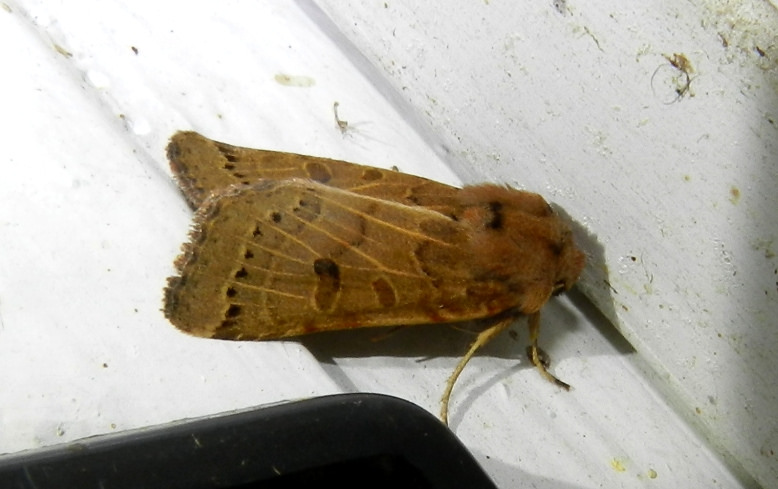Map Snapshot










95 Records
Status
New arrival to the eastern U.S. First report for U.S. collected in Potomac, Maryland in October 2015 (T. Mustelin). Later review turned up earlier U.S. records from Reston, Virginia, going back to October 2013 (BugGuide), indicating an earlier introduction to the United States. Native range is scattered across western Europe. Thanks to Tomas Mustelin, Hugh McGuinness, Tim Reichard, Bob Biagi, and Steve Nanz for their review of East Coast records.
Description
Compare very similar Variable Sallow.
Where To Find
Larvae apparently use various grasses and overwinter in that form (BugGuide).
Seasonality Snapshot
Source: Wikipedia
| Lunar underwing | |
|---|---|

| |

| |
| Scientific classification | |
| Domain: | Eukaryota |
| Kingdom: | Animalia |
| Phylum: | Arthropoda |
| Class: | Insecta |
| Order: | Lepidoptera |
| Superfamily: | Noctuoidea |
| Family: | Noctuidae |
| Genus: | Omphaloscelis |
| Species: | O. lunosa
|
| Binomial name | |
| Omphaloscelis lunosa (Haworth, 1809)
| |
The lunar underwing (Omphaloscelis lunosa) is a moth of the family Noctuidae. The species was first described by Adrian Hardy Haworth in 1809. It has a scattered distribution in western Europe including Spain, Scandinavia and Algeria.

This is a variable species, the forewings ranging from pale buff to dark brown although the paler forms are generally more common. The forewings are usually marked with two dark stigmata and a black streak near the apex. The hindwings are whitish marked with a dark moon-shaped crescent on the hindwing is partially diagnostic and which gives the moth its English name.
Description
[edit]The wingspan is 32–38 mm. Forewing varying from pale greyish ochreous to rufous and dark purple brown, the veins generally pale; upper stigmata distinct and filled up with dark, with distinct pale outlines; inner and outer lines double with paler centres, the inner obliquely curved out, the outer simply sinuous; submarginal line pale, preceded by a row of dark spots, and on costa by a black blotch or bar; hindwing whitish, suffused with grey, especially in the female, with large grey cell spot and interrupted submarginal band. The type form is dull red without pale veins; the red forms with pale veins are ab. rufa Tutt;the palest form of all is obsoleta Tutt without pale nervures; a somewhat darker, more brownish form, with the veins pale is humilis H. & Wwd.; brunnea Tutt has the ground colour deep red-brown with pale veins; in subjecta Dup. it is dark grey brown, the extreme development of which, agrotoides Guen., is blackish grey; — olivacea Vasq., from Spain, has the forewing pale olive ochreous, and rubra Vasq., also from Spain, has it pale reddish ochreous. .[1] The larva is light brownish with dark warts, each with a short brush.
Biology
[edit]This moth flies at night from August to October [1] and is attracted to light and flowers.


The habitat is grasslands, damp pastures, downland and parks and gardens. The larva feeds on all parts of various grasses, overwintering in this form.
- ^ The flight season refers to the British Isles. This may vary in other parts of the range.
References
[edit]- ^ Seitz, A. Ed., 1914 Die Großschmetterlinge der Erde, Verlag Alfred Kernen, Stuttgart Band 3: Abt. 1, Die Großschmetterlinge des palaearktischen Faunengebietes, Die palaearktischen eulenartigen Nachtfalter, 1914
- Chinery, Michael (1991). Collins Guide to the Insects of Britain and Western Europe.
- Skinner, Bernard (1984). The Colour Identification Guide to Moths of the British Isles.
External links
[edit]- Kimber, Ian. "73.193 BF2270 Lunar Underwing Omphaloscelis lunosa (Haworth, 1809)". UKMoths. Retrieved 23 October 2019.
- "Agrochola (Anchoscelis) lunosa (Haworth, 1809)". Fauna Europaea.
- "Agrochola lunosa". Lepiforum e.V.
- "Agrochola lunosa". De Vlinderstichting. (in Dutch)











